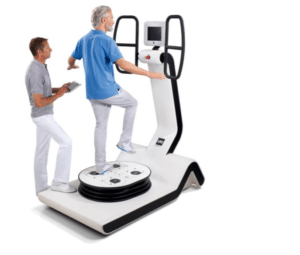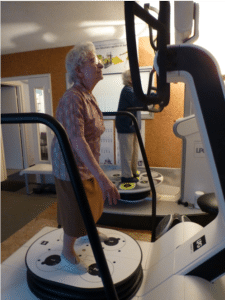Whole Body Rebalancing (WBR Therapy) is a relatively new approach to addressing imbalances in body movement. The body requires several essential ingredients to move around safely and efficiently:
- Flexibility and Mobility – Joints must be able to move through their entire range of motion; muscles, tendons and ligaments must be supple enough to allow these movements; and supporting soft tissues like skin and fasciae must be pliable and flexible.
- Dynamic Strength – The muscles must be able to produce speed and power when needed: jump, run or prevent a fall after a stumble.
- Static Strength – The same muscles must be able to hold a contraction for prolonged periods of time. For example, the trunk and leg muscles must be able to maintain tone to give us good posture.
- Balance and Coordination – All muscles, joints and ligaments must move together in harmony to produce good movement. The central and peripheral nervous system must be able to control everything so that the resulting movement is smooth and efficient.
In traditional rehabilitation most efforts are targeted at addressing the main problem at hand – stiffness of a certain joint, weakness of a certain muscle group, etc. WBR takes it one step further. All the deficits are measured and recorded and all are addressed, starting with the weakest and progressing from there to incorporate all deficits in exercises that require all the physical systems to perform.
The exercises are done in standing or sitting and incorporate elements of goals, targets and feedback.
WBR Therapy = Skilled Clinician + HUBER 360
Central to WBR Therapy are two essential components: the skilled clinician and the Huber 360. The clinician will assess the condition and determine the deficits that need to be addressed with the help of the Huber 360, a sophisticated assessment and exercise tool.
 The Huber 360 is a multi-axial motorized platform with multiple force sensors built into the foot plate and the handle bars. The system analyzes the the forces that are created by the body movements and then presents tasks and challenges to the patient through the custom software algorithm. Since the system constantly monitors the patient’s reaction, it can adjust the intensity and difficulty of the exercises on a real-time basis. The result is an individualized and tailored exercise environment that is unique to every patient.
The Huber 360 is a multi-axial motorized platform with multiple force sensors built into the foot plate and the handle bars. The system analyzes the the forces that are created by the body movements and then presents tasks and challenges to the patient through the custom software algorithm. Since the system constantly monitors the patient’s reaction, it can adjust the intensity and difficulty of the exercises on a real-time basis. The result is an individualized and tailored exercise environment that is unique to every patient.

The platform moves in multiple directions and at different speeds while the patient attempts to maintain balance and follow a target on the screen by shifting their weight and adjusting their position. Depending on which program is selected and what position the patient is in, the exercise will result in stretching, strengthening and improved coordination and balance. The system is used for a multitude of conditions: to improve strength and stability after orthopedic surgery, to decrease fall risk, to manage dizziness and balance disorders, to improve posture, and much more.
Joint health
WBR Therapy with the Huber 360 improves the patient’s strength, suppleness, coordination, concentration, posture and balance. The device offers hundreds of gentle on-board exercises that enable safe and complete body rehabilitation: back, upper and lower limbs. With improved mobility, dynamic strength and stability, joints are better protected and the body comes into better alignment and balance.
Most joint disorders benefit from this approach. Some common conditions treated include low back pain, rehabilitation after knee, hip or shoulder surgery, osteoarthritis, bulging discs, and more.
 Low back pain in particular has been shown to benefit from work on the Huber 360. In a comparative trial, patients working on the Huber 360 had better outcomes than those exercising in a Pilates exercise program. The skilled clinician can utilize the gentle movements of the Huber 360 platform to position the patient’s low back joints in just the right position to facilitate a manual mobilization or manipulation.
Low back pain in particular has been shown to benefit from work on the Huber 360. In a comparative trial, patients working on the Huber 360 had better outcomes than those exercising in a Pilates exercise program. The skilled clinician can utilize the gentle movements of the Huber 360 platform to position the patient’s low back joints in just the right position to facilitate a manual mobilization or manipulation.
Circulatory health
Exercise on the Huber 360 is of significant benefit to circulation. Effective circulation is very dependent on movement and muscle function. The more one moves and the better the muscles perform, the better circulation will be. Many circulatory disorders benefit from WBR Therapy, including edema in the legs, venous insufficiency, arterial insufficiency, lymphedema and more.
Improving Balance and Fall Prevention
Falls are of particular concern in the elderly population. Falls occur more frequently as one ages and when they do, serious injuries can be life changing events. In fact, falls are the leading cause of fatal and non-fatal injuries for older Americans. Falls threaten seniors’ safety and independence and generate enormous economic and personal costs.
Consider the following statistics:
- One in four Americans aged 65+ falls each year.
- Falls are the leading cause of fatal injury and the most common cause of nonfatal trauma-related hospital admissions among older adults.
- A growing number of older adults fear falling and, as a result, limit their activities and social engagements.
- This can result in further physical decline, depression, social isolation, and feelings of helplessness.
 Fortunately, falls are not an automatic consequence of aging; something can be done to prevent them or at least minimize the risk of them occurring.
Fortunately, falls are not an automatic consequence of aging; something can be done to prevent them or at least minimize the risk of them occurring.
The evidence-based solution to preventing falls is exercise to improve dynamic and static muscle strength, improve flexibility, and improve coordination and balance. WBR Therapy with the Huber 360 provides the ideal platform to deliver this kind of comprehensive approach. In addition, the feedback component of the Huber 360 provides a very important cognitive component to the rehabilitation session, which increases the patient’s participation and engagement.
References
Jurakic, Zrinka Greblo, et al. “Effects of feedback-based balance and core resistance training vs. Pilates training on cognitive functions in older women with mild cognitive impairment: a pilot randomized controlled trial.” Aging clinical and experimental research 29.6 (2017): 1295-1298.
Guiraud, Thibaut, et al. “Whole-body strength training with Huber Motion Lab and traditional strength training in cardiac rehabilitation: A randomized controlled study.” Annals of physical and rehabilitation medicine 60.1 (2017): 20-26.
Letafatkar, Amir, et al. “The efficacy of a HUBER exercise system mediated sensorimotor training protocol on proprioceptive system, lumbar movement control and quality of life in patients with chronic non-specific low back pain.” Journal of back and musculoskeletal rehabilitation 30.4 (2017): 767-778.
Couillandre A, Duque Ribeiro MJ, Thoumie P, Portero P. “Changes in balance and strength parameters induced by training on a motorised rotating platform: A study on healthy subjects.” Ann Readapt Med Phys. 2008 Mar;51(2):59-73.